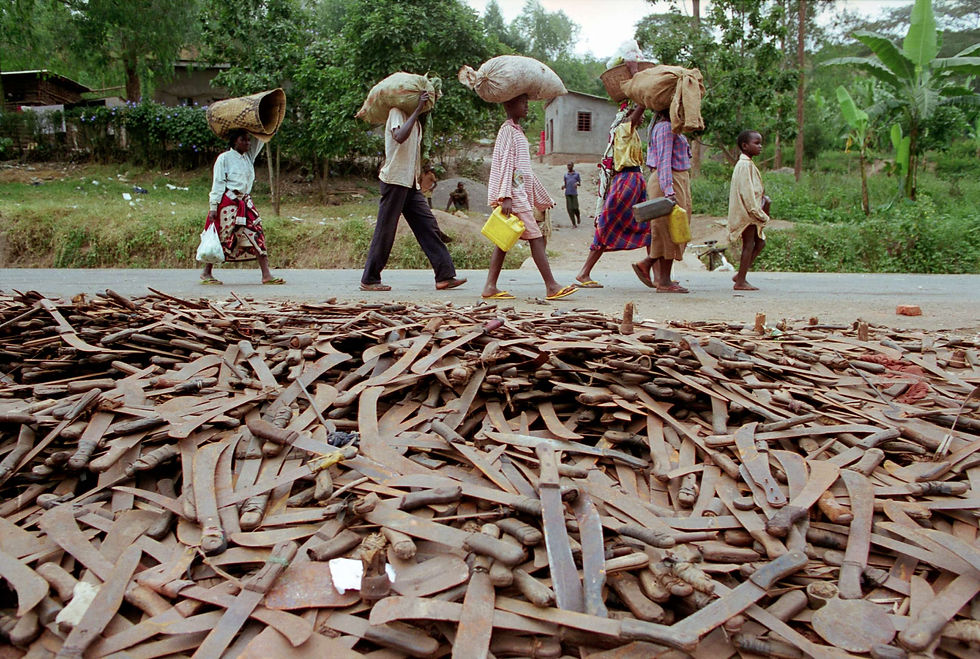Exploring the Legacy of the 1994 Genocide Against the Tutsi
- Mugisha Israel
- Jul 11
- 4 min read
Updated: Jul 16
The memories of the 1994 Genocide against the Tutsi continue to shape Rwanda’s national identity and global memory. This tragic event, defined by unimaginable violence and loss, left a deep scar on the country and serves as a powerful reminder of the consequences of hatred and division. In this blog, we explore the historical background, the role of propaganda, the international response, and how Rwanda has moved forward through healing and rebuilding.
Understanding the History of the 1994 Genocide against the Tutsi
The 1994 Genocide against the Tutsi occurred between April and July of that year. In just 100 days, an estimated 800,000 to 1,000,000 people were killed, including Tutsi and moderate Hutu who opposed the extremist ideology.
The roots of the genocide lie in decades of ethnic tension. Colonial rule, especially under Belgium, had reinforced divisions by favoring the Tutsi minority in education and leadership. Over time, resentment grew among the Hutu majority, and political leaders later weaponized these divisions.
The immediate trigger came on April 6, 1994, when the plane carrying President Juvénal Habyarimana was shot down. His death unleashed a coordinated and systematic campaign of mass murder, targeting Tutsi communities across the country.

Propaganda’s Role in the 1994 Genocide against the Tutsi
Propaganda played a dangerous and influential role in fueling the genocide. Radio Télévision Libre des Mille Collines (RTLM) broadcast hate speech that dehumanized the Tutsi and called for their extermination.
These broadcasts reached deep into communities, convincing many Hutu civilians that their Tutsi neighbors were enemies. The manipulation of information not only incited violence but also provided it with a false justification. It showed the world how powerful and destructive words can be when used to divide and incite.

The International Response to the 1994 Genocide against the Tutsi
The international response to the genocide was marked by hesitation and inaction despite early warnings and calls for help; world leaders and global institutions failed to intervene in time.
The United Nations had a peacekeeping presence in Rwanda, but their troops were too few and their mandate too limited. Appeals for reinforcements were ignored or delayed. Many governments even avoided using the word “genocide,” which would have triggered legal obligations to act.
This failure is now widely acknowledged and has led to global discussions about the moral duty to protect civilians in the face of mass atrocities.
Rebuilding Rwanda: Justice and Healing
In the aftermath, Rwanda faced the unimaginable challenge of rebuilding a broken society. Towns were destroyed, families were shattered, and survivors were left to live alongside those who had committed crimes.
The Rwandan government, under the leadership of President Paul Kagame, introduced several initiatives aimed at reconciliation and justice. One of the most notable efforts was the creation of Gacaca courts—community-based tribunals that allowed survivors and perpetrators to speak openly and seek resolution.
These courts were not perfect, but they provided a platform for truth-telling and helped many communities begin the long process of healing. Beyond Gacaca, the government has invested heavily in unity programs, education, infrastructure, and the removal of ethnic labels from identification documents.

Lessons Learned
Exploring the legacy of the 1994 Tutsi Genocide leads to several critical lessons. Firstly, the importance of timely intervention and effective communication in preventing genocide cannot be overstated. History underscores the need for vigilance in recognizing early warning signs of mass atrocities.
Secondly, the role of education in fostering tolerance and understanding among different ethnicities is vital. Educating younger generations about the events of the past, along with promoting shared cultural understanding, can pave the way for a more harmonious society.
Lastly, the experience of Rwanda illustrates the resilience of human spirit and the capacity for forgiveness. The efforts to reconcile and rebuild demonstrate that even in the aftermath of unimaginable tragedy, hope and recovery are possible.
A Glimpse into the Future
As we honor the memory of those lost during the 1994 Genocide against the Tutsi, it is essential to reflect on how we can ensure such tragedies are never repeated. Many organizations and memorials are dedicated to preserving the memory of the lives lost and educating future generations about the dangers of hatred and intolerance.
In Rwanda today, many memorials commemorate the victims, including the Ntarama Genocide Memorial. The memorial serves as a solemn reminder and a place of reflection for visitors, ensuring that the legacy of the genocide continues to inform present and future generations. You can learn more about this significant location by visiting the 1994 Tutsi Genocide.
In conclusion, the 1994 Genocide against the Tutsi was one of the darkest moments in recent human history. But Rwanda's journey since then tells a story not only of sorrow, but of resilience, strength, and hope.
By acknowledging the truth, investing in reconciliation, and committing to education and unity, Rwanda continues to inspire the world. As we remember those who were lost, we are called to do more than mourn—we are called to ensure that such horrors never happen again.



Comments